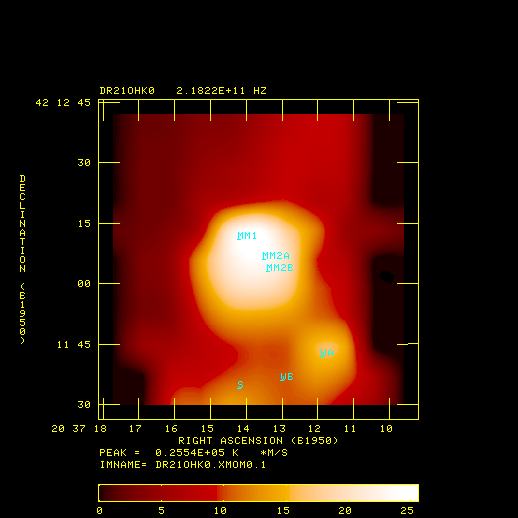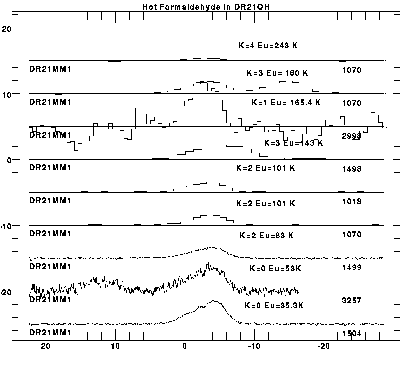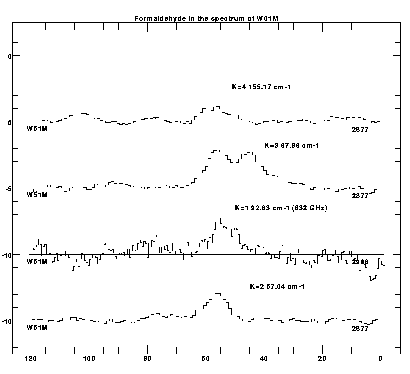We determine the physical conditions in
warm dense cores in molecular clouds
via observations of the submillimeter wavelength transitions of
formaldehyde (H2CO).
H2CO is the ideal molecule for this purpose, since
its numerous transitions in the submillimeter spectrum allow independent
temperature and density determination of the emitting gas. The
transitions in the 650 GHz atmospheric window arise from gas
which is too warm for depletion onto grains to have hidden it from view.
The lowest energy transitions lie at levels 160 K above ground, while
the highest energy transitions in the window are the K=8
transitions arising
from levels more than 1000 K above the ground state. Since formaldehyde is
destroyed at temperatures above about 300K, little emission is expected from
the most highly excited transitions. However, Schilke (private communication)
reports
the detection of the K=7 transitions at 654 GHz toward IRc2 in OMC1. These
lines, which arise from levels 800 K
above ground may occur in a transient chemistry, and provide information
on conditions in shocked or ablated material quite close to the
young star(s) buried in the dense core
(Wootten, Loren and Bally 1984 Ap. J. 277, 189). We report observations
of several highly excited
lines of formaldehyde towards warm HII regions made with the Caltech
Submillimeter Telescope (CSO). Our attempt to understand
the conditions under which its emission is excited in star-forming
molecular clouds confirms that denser, hotter regions give rise to
more highly excited
submillimeter transitions than heretofore found. In DR21(OH)MM1, for
example, densities a factor of four higher than suggested by Mangum and
Wootten (1993, Ap. J. Supp. 89, 123) are required to reproduce the strength
of the 9(19)->8(18) transition observed at 632 GHz.
The CSO is operated by the California Institute of
Technology under funding from the National Science Foundation,
Contract No. AST-93-13929.
 Integrated intensity in the 218.2 GHz K=0 line of formaldehyde observed
with the IRAM 30m telescope and its 12" beam. Sources identified in
interferometric ammonia images are shown.
Integrated intensity in the 218.2 GHz K=0 line of formaldehyde observed
with the IRAM 30m telescope and its 12" beam. Sources identified in
interferometric ammonia images are shown.
 Formaldehyde profiles towards DR21OH-MM1.
Formaldehyde profiles towards DR21OH-MM1.
 Formaldehyde profiles towards W51M.
Formaldehyde profiles towards W51M.



Next: Back to Al's home page.
Al Wootten
Wed Oct 30 10:35:59 EST 1996


 Integrated intensity in the 218.2 GHz K=0 line of formaldehyde observed
with the IRAM 30m telescope and its 12" beam. Sources identified in
interferometric ammonia images are shown.
Integrated intensity in the 218.2 GHz K=0 line of formaldehyde observed
with the IRAM 30m telescope and its 12" beam. Sources identified in
interferometric ammonia images are shown.
 Formaldehyde profiles towards DR21OH-MM1.
Formaldehyde profiles towards DR21OH-MM1.
 Formaldehyde profiles towards W51M.
Formaldehyde profiles towards W51M.